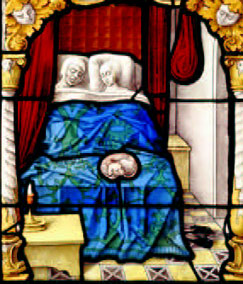The Old Testament tells us that Sarah, wife of Tobias, was a dangerously energetic woman. She had “brought death” to seven previous husbands on seven previous wedding nights, so what was poor old husband number eight to do? Fortunately for Tobias, the Archangel Raphael stepped in with some timely advice. Do not consummate the marriage for three days and all will be well; and so it came to pass, in this quintessential parable of chastity rewarded.
This is the story eloquently told in the first, exquisite panel of stained glass encountered by visitors to the National Gallery’s compelling new exhibition: “Art of Light: German Renaissance Stained Glass”. Created by an anonymous artist-craftsman working in the Lower Rhine in about 1520, the panel in question shows the couple safely tucked up in bed together, the covers drawn decorously up to their chins. Sarah is a doe-eyed blonde whose head lolls sleepily on a plump white pillow. Tobias, who has a prominent Adam’s apple and a somewhat knobbly face to match, inclines towards his wife but, obedient to his angelic instructions, refrains from embracing her. The artist has transplanted the scene to his own time and place, setting it in a well-to-do Rhenish merchant’s house, captured in the finest detail and using the very latest in Renaissance pictorial techniques, such as mathematically calculated perspective and trompe l’oeil illusionism. A pair of leather shoes lies discarded on a chessboard floor of alternating brown and yellow tiles. An unlit candle – symbol of temptation extinguished – stands on a sideboard decorated with shivers and squiggles of paint artfully arranged to suggest the grain of wood. A looped-up swag of bed curtain, positively Van Eyckian in richness of colour and subtlety of depiction, has been conjured from a teardrop of deep red stained glass....


